The Way It Is/ Forty years covering American racingby Gordon Kirby |
 This week I'm taking the liberty of reminiscing a little about the 39 years I've enjoyed covering motor racing nationally across the United States, Canada and occasionally elsewhere around the world. Back in 1973 I'd messed around in racing for a few years, writing part-time for Autosport and a Canadian weekly called Wheelspin News as well as helping my old friend David Loring race a string of Caldwell and Merlyn Formula Fords. After a memorable year with David in the UK I got a telegram from Autosport in February of 1973 asking if I would be interested in replacing Pete Lyons as the magazine's American correspondent because Pete was moving on to cover Formula One.
This week I'm taking the liberty of reminiscing a little about the 39 years I've enjoyed covering motor racing nationally across the United States, Canada and occasionally elsewhere around the world. Back in 1973 I'd messed around in racing for a few years, writing part-time for Autosport and a Canadian weekly called Wheelspin News as well as helping my old friend David Loring race a string of Caldwell and Merlyn Formula Fords. After a memorable year with David in the UK I got a telegram from Autosport in February of 1973 asking if I would be interested in replacing Pete Lyons as the magazine's American correspondent because Pete was moving on to cover Formula One.
As I recall they offered me 1,200 pounds for the year to cover the Can-Am and Formula 5000 series, USAC's three 500-mile races, the Daytona 500, plus the Daytona 24 hours and Sebring. It wasn't about the money of course. It was an opportunity to pursue exactly what I wanted to do and I began my work as Autosport's American correspondent at the opening American Formula 5000 race of the season at Riverside on the last weekend of April, 1973. I'd driven cross country from the east coast in my Ford van accompanied by Dick Carey, my co-driver and photographer. We started at Riverside, then drove up to Laguna Seca for round two of the F5000 series before motoring east to Indianapolis for the first weekend of qualifying at the Speedway. Next came another F5000 race on the road course at the Michigan Int'l Speedway followed by that year's disastrous, rain-delayed Indy 500 which took three days to run, ending in tragedy with the deaths of Swede Savage and crewman Armando Teran. 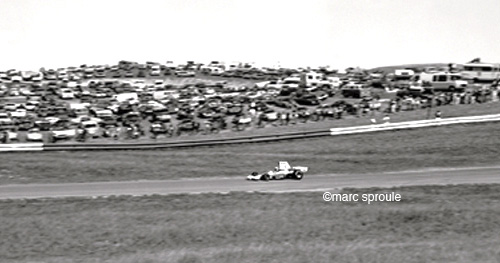 © Marc Sproule The following year I was at a Formula Ford race in England with David when we heard the news that Bert Hawthorne had been killed in a Formula 2 race at Hockenheim. We had met Bert the previous year when he was racing Alan McCall's Tui in Formula B with great success and also a Titan Formula Ford and David and he enjoyed some great battles on the track. Bert was a lovely guy, a tremendous racer and an unrestrained party animal and it was a real blow to both of us to hear about his death. It was an even bigger blow to Alan McCall who put everything into launching Hawthorne's promising career. McCall was a superb fabricator who had suffered the loss of another highly-talented driver four years earlier when he worked at Team Lotus on Jim Clark's F1 and Indy cars. Clark of course was killed in an F2 Lotus at Hockenheim in 1968. Over time I've had the tough job of writing too many obituaries of young men I knew and admired. I think of people like BJ Swanson, Gilles Villeneuve, Gordon Smiley, Al Holbert, Scott Brayton, Jeff Krosnoff, Greg Moore, Dale Earnhardt, Tony Renna and Dan Wheldon. Thankfully, that part of the job has become less frequent in recent times courtesy huge strides in safety in all aspects of the sport. Back in the seventies I supplemented my small income from Autosport by freelancing for AutoWeek or Competition Press, as it was then known. I also worked for a nice little underfinanced magazine called Formula which became Race Car and in 1980 I helped Paul Oxman found OnTrack. It was great fun and I helped fill OnTrack's pages with race reports, news and features about Indy cars, Can-Am, NASCAR, Formula Atlantic, Super Vee and Formula One too. I hoped we could develop OnTrack into a serious rival to National Speed Sport News but the resources weren't there to make it happen. 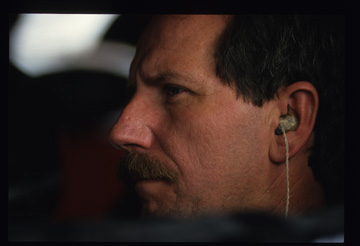 © Paul Webb Meanwhile, I had been approached by George Damon Levy to work with him on AutoWeek's transformation from a newspaper into a magazine. George was hired by publisher Leon Mandel to edit the magazine and oversee its development in its new guise. Levy was a bright young man with tremendous passion for cars and racing and a very good writer and editor too. George hired me as a motor sports editor-at-large to cover a little of everything with a focus on Indy cars. It was a great period of time because George was a pleasure to work with but after three or four years he decided to leave AutoWeek and move on to his current very successful career as an advertising copywriter and consultant to the automotive industry. Without George life wasn't as much fun at AutoWeek and at the end of 1989 Leon Mandel and I mutually agreed that we would part ways. Of course, I continued throughout this time to work as Autosport's man in America and enjoyed regular freelance work from other magazines around the world from France, Germany and Switzerland to Australia, Japan and Mexico. But my goal was still to help create a successful American racing magazine and in 1991 I started talking to my old friend Paul Pfanner about tackling the job one more time. Pfanner and I first met almost twenty years earlier when he was the art director of Formula magazine and we had also worked together at OnTrack. In the spring of '92 Pfanner launched Racer magazine with me serving as editor-at-large, focusing on Indy cars but writing a little about as much as possible. My good friend John Zimmermann was Racer's original editor and no better man could there have been for the job. John and I had worked together at OnTrack, IndyCar and AutoWeek and he did a great job of pulling together the magazine every month amid the meager but hopeful resources Pfanner was able to muster in those early days. 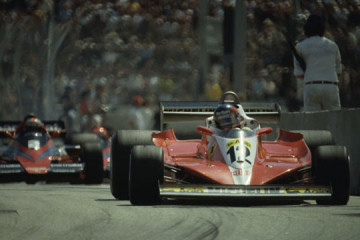 © Paul Webb Haymarket had talked for years about the possibility of creating an Autosport America and through the late nineties various approaches were discussed. Eventually Haymarket decided to buy Racer and as all this unfolded over a two or three-year period the CART/IRL civil war also began to burn in earnest. Inevitably the CART/IRL politics bled into the politics and realities of running an American racing magazine with a focus on Indy car racing and amid editorial frustration and increasing political turmoil I resigned from Racer at the end of 1997. Two years later I rejoined for a short period to help produce a new magazine called Champ Car but it didn't last long and as the new century arrived I departed Racer for good. Of course, Pfanner recently bought Racer back from Haymarket. I'm sure he's learned a lot over the last dozen years and developed a much stronger overall business model and I wish him good luck on redeveloping the magazine. He has a pair of first-rate, experienced editorial leaders in Laurence Foster and David Malsher and if he allows them their heads I'm sure they will be successful. Meanwhile, back in 2000 I had decided I needed a change of pace and thanks to Joe Rusz and Andy Bornhop, I was invited to write a monthly column in Road & Track about CART and then Champ Car, plus occasional features. I also started pushing my book business, writing Bobby Rahal's biography in 1998 and Mario Andretti's in 2001, both published by David Bull. In 2003 Bull also published 'A Winning Adventure' a book co-authored with John Oreovicz about Honda's successful entry into Indy car racing. And in 2000 I co-wrote a biography of Greg Moore with Dan Proudfoot and Jim Taylor for Whitecap Books in Canada. I continued to work for Autosport through the spring of 2005 by which time I had decided I was no longer interested in writing race reports and news stories. I wanted to move on with my life and career and find a forum to write in-depth stories and commentary in a manner I preferred that was no longer available in the fast-changing media landscape and rapidly dwindling writing assignments covering Indy cars or American racing as a whole. 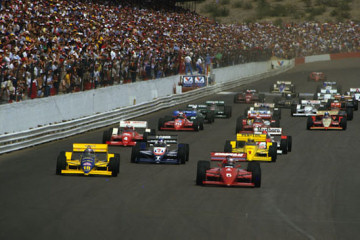 © Paul Webb Like Nigel and me, Damien is an ex-Autosport man with plenty of experience who enjoys the support of veteran Motor Sport writers like Gordon Cruickshank, Rob Widdows and Doug Nye and comparative newcomers like Ed Foster. Motor Sport also enjoys a great advertising team and a healthy ad base which is essential to any magazine's success, particularly in today's tough economic and print media environment. I've also been fortunate to find a great book publisher in Joe Freeman at Racemaker Press in Boston. Four years ago I published my Rocket Rick Mears biography, titled 'Rick Mears--Thanks', with the Crash Media Group in the UK, publishers of Autocourse for whom I've written an annual review of the American racing season every year since 1973. But it was disappointing to have to go to England to find a publisher for a book about an American racing hero and I was determined to find an enthusiastic US publisher for my history of Carl Haas Auto and Newman/Haas Racing. I spent a good deal of time writing this book through 2009 and '10 and about eighteen months ago I found the right man when I met Joe Freeman who is an avid racing enthusiast and excellent writer and editor. He's also an extremely knowledgeable vintage Indy car collector and racer whose company, Racemaker Press, has published many first-class books about vintage and historic racing in America including Joel Finn's award-winning Carribean Capers and Gordon White's history of Leader Card Racers. Just recently, Racemaker published Jim O'Keefe's definitive biography of Frank Lockhart, co-authored with Racemaker's business manager Sarah Morgan-Wu, and we hope to publish our Newman/Haas book sometime next year. As we get closer to a publication date we'll be sure to let all of you know when and where we'll launch the Newman/Haas book. 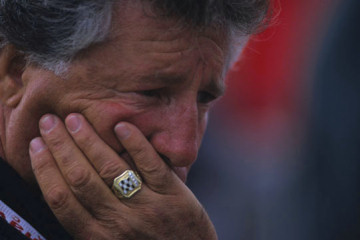 © Paul Webb So I count myself a lucky man these days to enjoy working for a great magazine in Motor Sport and an equally first-class book publisher in Racemaker Press. At Long Beach last week I had dinner one evening with a small group of my friends and colleagues---John Zimmermann, David Phillips, John Oreovicz and Paul Webb--to celebrate the start of my 40th season. JZ now is the associate editor of Casey Annis's Vintage Race Car magazine. David works for Iracing.com after many years covering Indy car racing for the likes of OnTrack, AutoWeek and Racer. John O covers Indy cars and drag racing for ESPN.com while Paul is a widely-experienced, first-rate motorsports photographer. We dined at John Morris's McKenna's on the Bay where we traded a few toasts and told each other old stories--a jolly time was had by all. Looking back, I can only echo comments made in this space in recent weeks by Roger Bailey and Jim Hall. Both Bailey and Hall stressed the point that, 'It's all about the people.' And indeed it is. Over more than forty years in motor racing I've had the pleasure of meeting and enjoying the company of many independent-minded, free-thinking, highly-motivated people--drivers, team owners, designers and engineers, team managers and crewmen, even writers and journalists! Like Bailey and Hall I've enjoyed a heck of a ride and if I had the chance to do it all over again I wouldn't change a thing. I hope I'm fortunate enough to enjoy another decade or two doing what I love. |
Auto Racing ~ Gordon Kirby Copyright 2012 ~ All Rights Reserved |
